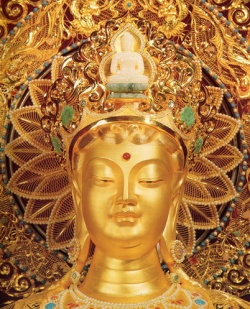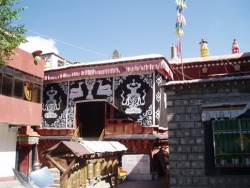The Protector House Itself
The Trode Khansar tsen khang itself is a two story structure. Previously, there was also a third story that housed the Dorje Shugden oracle, but it was removed during the Cultural Revolution (TOL, 196). The first story is slightly below ground level and is not used for religious purposes. On the south side, stairs lead up to the front entrance which is enclosed in a portico. This portico’s walls are painted with the four directional protectors (rgyal chen sde bzhi) as is typical with most temples and monasteries.
The front entrance leads directly into the main eight-pillar hall of the building and is approximately 10 meters wide. On the east and west sides of the main hall are residential rooms for monks. Behind the main hall, protruding from the north side of the building is a room (lcog)23 used for rituals by the resident monks. This room has a skylight and black colored walls with paintings of various protectors. On the north side of the room are statues of statues of Je Tsongkhapa, founder of the Gelug sect, and his principal students Gyaltsab Je and Khedrup Je.
The murals of the main hall are of important historical significance. In relation to Dorje Shugden are murals of his Jataka ('khrung rabs) or previous life stories. This includes a mural featuring his lives as previous masters:
Manjushri during the life of Buddha,
Birwawa as one of the Mahasiddhas in medieval India,
Khache Panchen Shakya Shri as a Kashmiri scholar who traveled to Tibet and disseminated some important lineages,
Sakya Pandita and Buton as early Tibetan translators and scholars,
Panchen Sonam Dragpa, Sonam Yeshe Wangpo, Ngawang Sonam Geleg Pelzang and Tulku Dragpa Gyaltsen as a series of masters of the Gelug tradition founded in the 14th century.
The Temples of Lhasa also has photographs of murals of Manjushri as Jampel Mawa'i Senge (TOL, 198) and Avalokiteshvara as Yellow Amoghapasa 24 (TOL, 194). Other murals feature important stories of how Dorje Shugden was urged to become a protector in the presence of Je Tsongkhapa as his student, Dulzin Dragpa Gyaltsen. In particular, Je Tsongkhapa is surrounded by other monks and depicts the protector Nechung arriving riding a snow lion holding a bow and arrow. Nechung in the form of a boy interrupted the teachings three times when Dulzin Dragpa Gyaltsen told him to stop. Dulzin Dragpa Gyaltsen is then depicted standing up, at which point he promises Nechung to protect Je Tsongkhapa’s tradition in the future. Next, Je Tsongkhapa is depicted as being delighted and offers Dulzin Dragpa Gyaltsen a skull cup filled with nectar.25
There are several known manifestations of Dorje Shugden, such as him riding a black horse which is popular in the Sakya tradition. The form of him riding a snow lion and holding a sword is the most popular in the Gelug tradition, starting in probably the 19th century. One interesting difference in the iconography of several of the statues and paintings of Dorje Shugden in Trode Khangsar is that he is holding a club instead of a sword. The significance of this particular iconographic detail is due to the manifestation the Fifth Dalai Lama witnessed, which is envident in the praise and confession written by him:
Robes of a monk, crown adorned with rhinoceros leather hat,
Right hand holds ornate club, left holds a human heart,
Riding various mounts such as nagas and garudas,
Who subdues the mamo’s of the charnel grounds, praise to you!
23 The word lcog refers to the shape of a building, which is square but the walls slightly taper inward going toward the ceiling. This shape of the room is typically used for protectors and has come to be used interchangeably as the protector room.
24 There is a tradition of Yellow Amoghapasa coming from Kashmir Pandit Shakya Shri (kha che paN chen), a previous life of Tulku Dragpa Gyaltsen, which is probably why this mural is present.
25 Source: 2/2008 interview with anonymous person who stayed at the neighboring Trijang Labrang in the 1940s before the Chinese invasion.

